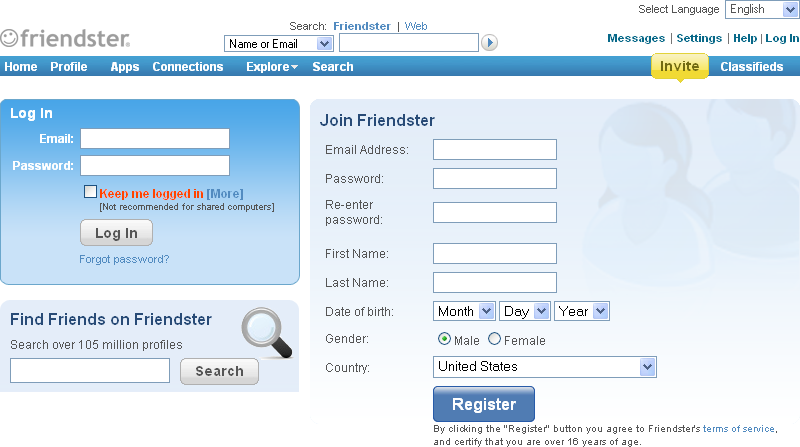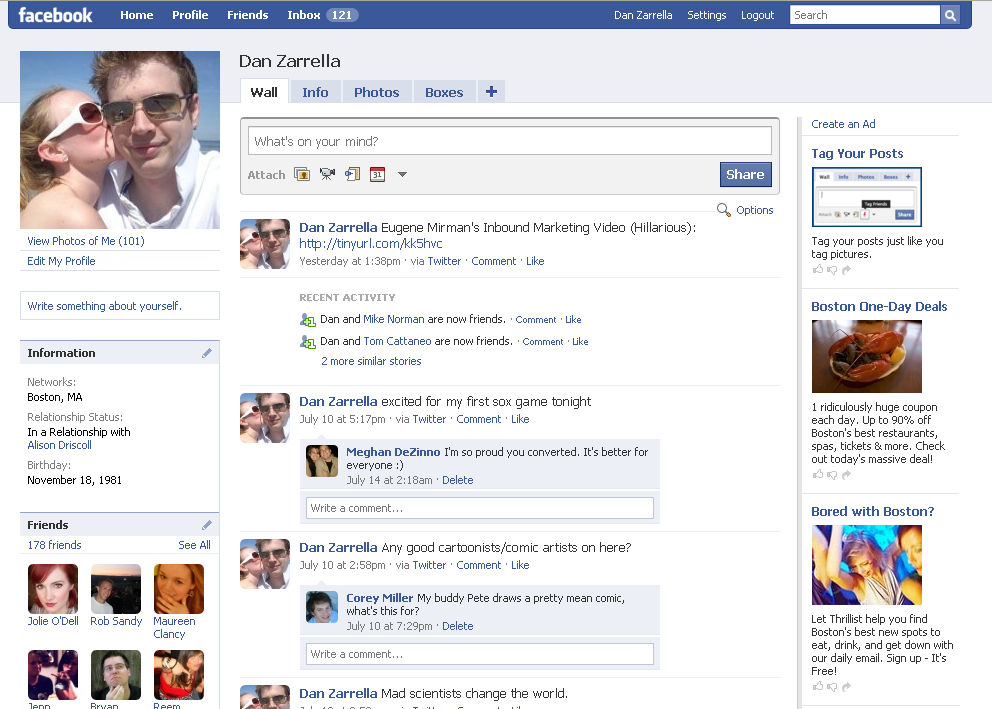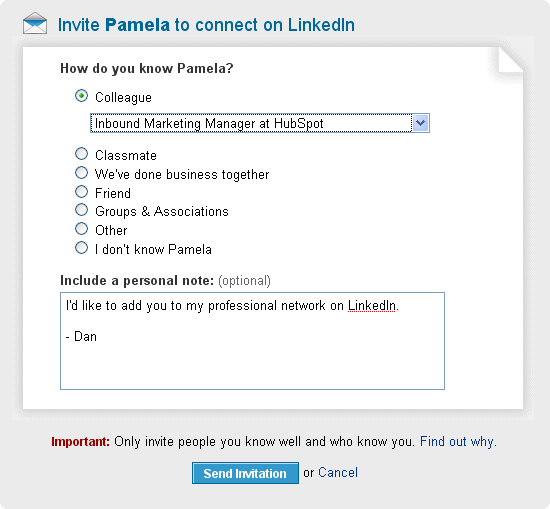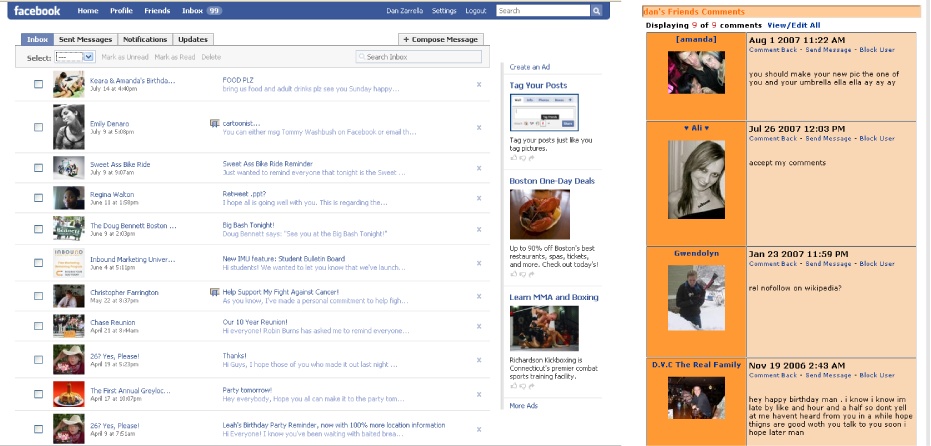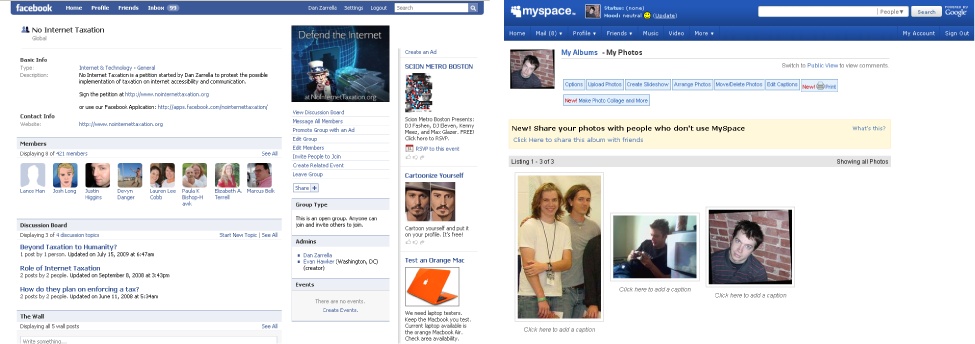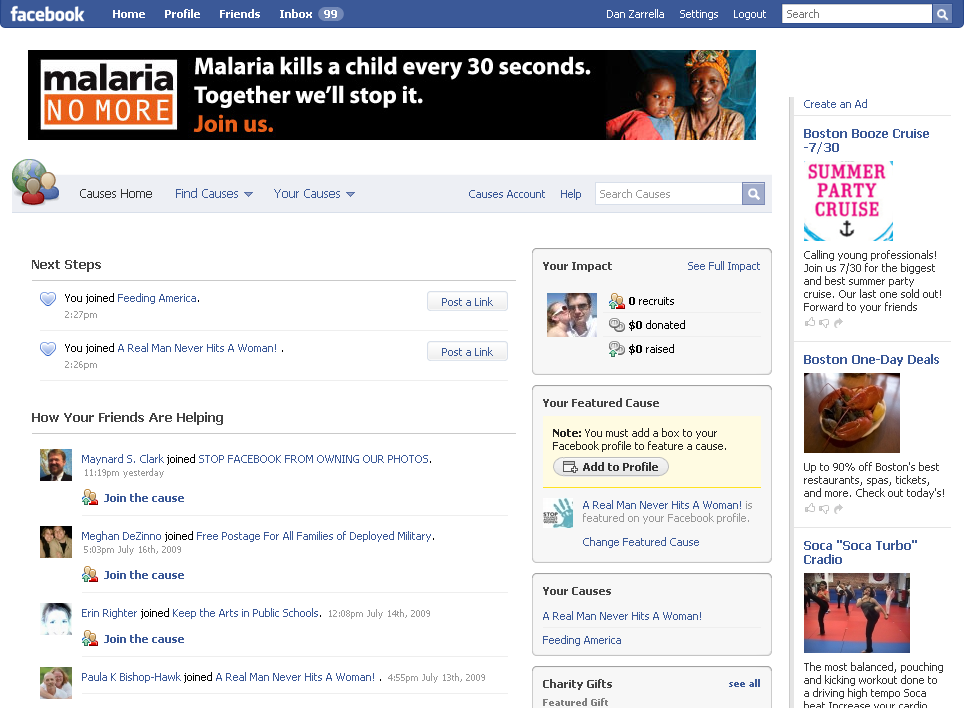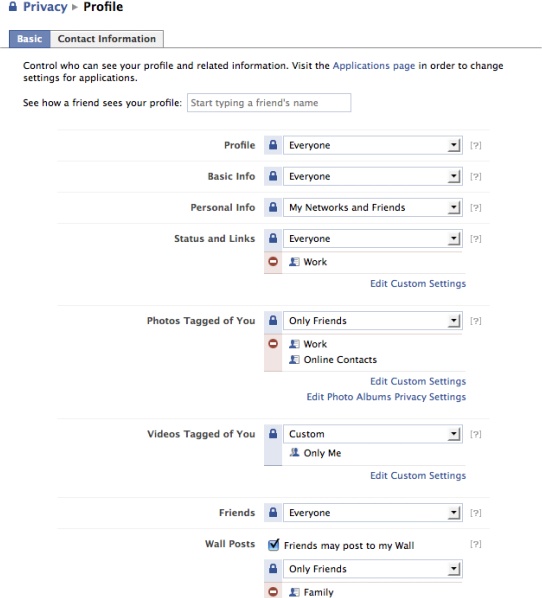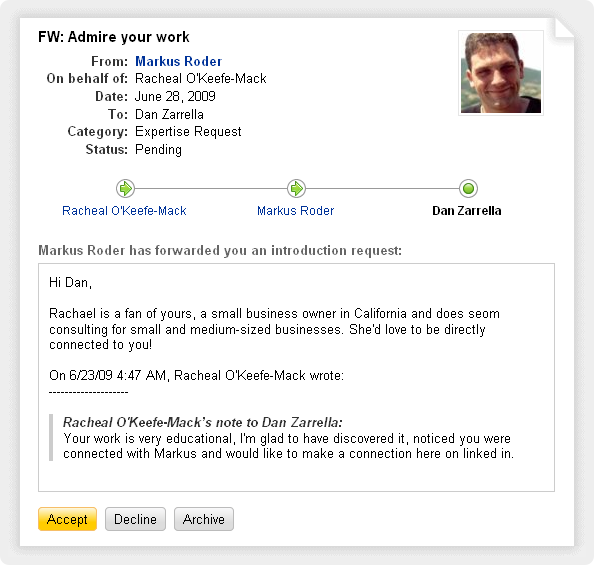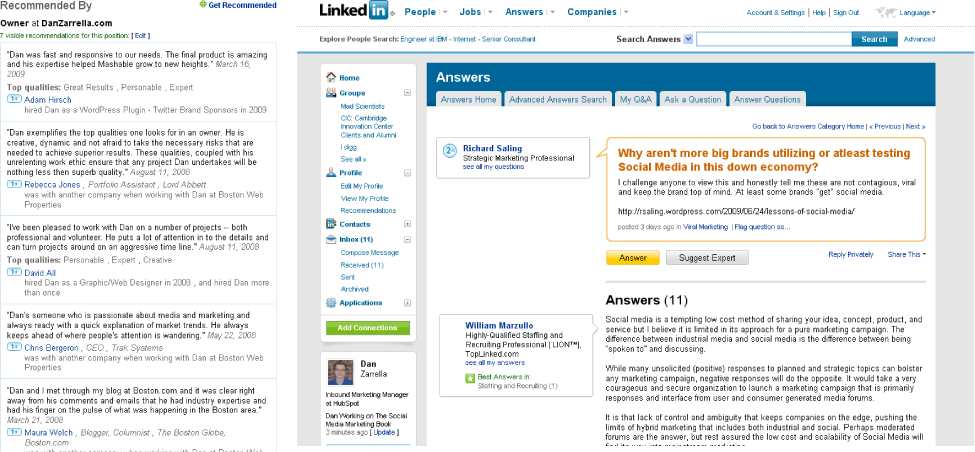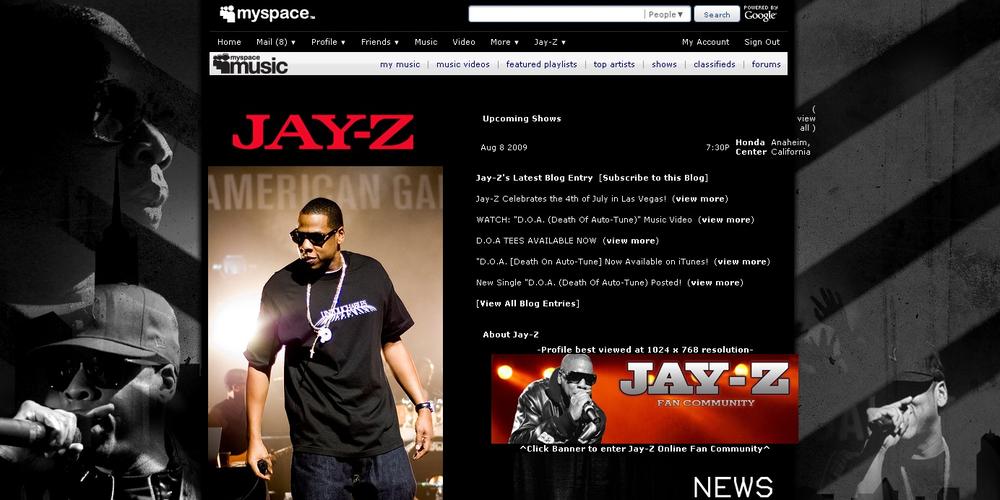A social network is a website where people connect with friends, both those they know offline and those who are online-only buddies. Social networking sites are a hot topic for marketers, as they present a number of opportunities for interacting with customers, including via plug-in applications, groups, and fan pages.
Each social network presents its own possibilities and challenges. Users of individual sites have different expectations of commercial behavior. In this chapter, I'll introduce you to the three most popular networks and their unique features.
The roots of online social networking can be traced to the 1980s bulletin board systems (BBSs). These systems allowed users to log in—through very slow connections—to share software and data as well as send private messages and post to public message boards. Due to the high cost of the long distance calls that would be required to access BBSs in other parts of the world, most of these were very local communities.
The late '80s and early '90s saw the rise of the desktop applications CompuServe, Prodigy, and AOL. Far more feature-rich than BBSs, these systems allowed users to connect to the Internet and create personal profiles, post events, chat, and send public and private messages.
As the World Wide Web grew in popularity, social networking moved to web-based applications. The first wave was built for specific functions or audiences. In 1995, Classmates.com and Match.com were created; both remain fairly popular sites in their niche. In 1999, more targeted networks were launched, including BlackPlanet.com, MiGente.com, and AsianAvenue.com.
The modern era of social networks began in 2002, when Jonathan Abrams launched Friendster (see Figure 4-1). Inspired by Match.com, Abrams wanted Friendster to be a dating site that wasn't about dating. In what many consider to be one of the biggest financial mistakes in recent history, Friendster rejected a $30 million buyout offer from search giant Google.
In 2003, several employees of a marketing company now known as Intermix Media—which was later sued by then–New York Attorney General Elliot Spitzer for making malicious spyware applications—duplicated the core functionality of Friendster and launched MySpace. Initially powered by Intermix Media's large email lists, MySpace quickly became a leader among social networking sites. Thanks to its customizable user profiles and its focus on music, MySpace had a cooler image than its somewhat stodgy rival, Friendster. In July 2005, News Corporation purchased MySpace and its parent company for $580 million.
Then, in October 2003, a Harvard sophomore named Mark Zuckerberg hacked into the university's private dorm ID database and created Facemash, a site that let students compare two ID photos to select the more attractive one. Narrowly avoiding legal action, Zuckerberg went on to create "The Facebook," a social network that began as an exclusive site for Harvard students. Slowly the site allowed other colleges to join—initially only Ivy League schools, and then other colleges, and then, eventually, high schools. Finally, in 2006, anyone with an email address could sign up.
Sometime between April 2008 and February 2009, Facebook overtook the long-standing king, MySpace, as the world's most popular social network (see Figure 4-2 for an example of a Facebook page).
Social networking sites vary greatly based on their feature sets and raisons d'être, but there are some common elements across most of them. This section will introduce those elements.
The building blocks of a social network are user pages, known as profiles. Your profile page can include information about you, including employment information, educational history, relationship status, contact information, and interests and hobbies. It can link to your photos and your friends' profiles, and allow visitors to contact you, often through private and public messaging. Social networking sites differ widely in how much they allow you to customize your profile: MySpace allows custom backgrounds and graphics, Facebook lets you add new blocks of content from applications, and LinkedIn gives you very little control. It's a good idea to do whatever you can to make your profile reflect your personality and personal brand, but don't go crazy—everyone hates the seizure-inducing profile with alarmingly loud pop music.
Profiles are for real people. You should have a profile; your company's logo should not. Profiles contain personal information; a brand can't have a favorite movie or book. If your company has a recognizable spokesperson, you can create a profile for him; otherwise, stick to a page or group for your company information.
The most important action of a social network is the act of two people connecting. MySpace considers it friending regardless of the recipient, whereas Facebook reserves friending for individual people and calls it fanning when you connect with a brand. LinkedIn keeps it simple and calls everything connecting (see Figure 4-3).
Social networks were conceived to emphasize strong connections between people—the people you actually know in real life rather than your online buddies. Some users follow this maxim to the letter and will accept connection requests only from people they know well. Other users will connect with just about anyone. In either case, if you're sending a connection request to someone, and it isn't obvious how you know her, you should include a brief introductory sentence or two along with your request explaining why you should be friends.
Social networks impose limits on how many people you can connect to in a given amount of time. These restrictions are in place to thwart spammers trying to build giant networks; if you're running into warnings, you're probably doing something wrong and need to slow down. It's a building process, and there's no reason to go out and get a million friends in one day.
Note
I once worked on a political campaign on Facebook, where we set up a profile for the candidate and began searching for people who were sympathetic to the candidate's causes to friend. After a burst of connecting to lots of potential supporters, the site would warn us that we were sending too many requests, and eventually the account was suspended. Although our account was reinstated after we sent a few emails to tech support, the exact limit was never revealed—all Facebook ever said was "too many."
Social networks all contain some form of private messaging akin to email (see Figure 4-4). These are typically sent from one user to another, but they can also be sent by a group to all of the group's friends. The networks will generally send the recipient an email notification of a received message, so don't bombard people's inboxes with constant message spam. If you find yourself wondering how to automatically send these messages, you're doing something wrong.
Public messages are called comments in MySpace and wall messages in Facebook. Commenting sections can be found on profiles, photos, groups, events, and business pages. When posting a public message, remember that everyone can read it. Don't share anything you wouldn't send to your boss and your mother. Congratulations, happy birthday, good luck, and long-time-no-see messages are all popular public messaging topics.
Marketers have been guilty of spamming the public message sections of related groups and pages—for example, while working for that politician I mentioned earlier, we were warned about "too many" wall posts. But don't be afraid to congratulate people on recent accomplishments.
Most social networks contain the concept of a group—a collection of people joined by some common interest (see the lefthand side of Figure 4-5 for an example). Group members can share news and discussions, and the group's administrators can send private messages to everyone.
Nonmarketers create groups for a plethora of reasons, including the I-lost-my-cell-so-send-me-your-numbers group and the save-such-and-such-TV-show group. Starting and joining a group requires only a small amount of commitment in time and resources, and little to no member involvement; as a result, many people belong to tons of seemingly pointless groups. LinkedIn is the exception to this rule, as it displays the logos of the groups you're a member of on your profile, meaning that many users are more selective in deciding which groups to join.
One of the most popular features of social networking sites is the ability to share photos. In fact, Facebook's photo-sharing feature is more popular than all of the other photo-sharing sites on the Web combined. You can upload pictures of yourself and your friends, and tag people in the images with their names. Photos can also have their own comment sections, allowing you and your friends to talk about them.
Campaigns can be designed to encourage users to take photos that include your product and to post them to Facebook and MySpace (see the righthand side of Figure 4-5 for an example of MySpace photos).
Most social networks will allow you to create an event and invite your friends to attend it. These events most commonly occur in the real world, but some are online-only events. RSVP functionality is included, as are commenting and photo uploads.
Anytime you're hosting a local event, set up a social networking event page. Use it to invite all your business's fans to come and meet people from your company.
Social networks have exposed their functionality through application programming interfaces (APIs) to developers, allowing them to create applications that plug into their site. Some applications function as add-ons to a profile or page enhancing that functionality, whereas others work more like standalone applications inside the network that leverage the functionality contained in the site.
Some of the most popular applications extend existing social networking functionality by enhancing public messaging systems, adding calendars, or allowing you to indicate which connections you're related to. Other popular apps facilitate philanthropy (as shown in Figure 4-6), or allow you to play games such as Scrabble and poker with your friends.
Applications require technical resources and programming capabilities, but they can be worthwhile additions to a social media marketing campaign. The best apps will allow people to communicate and interact with their friends rather than just act as advertisements for a product.
Several social networking sites have begun to allow their users to post messages answering a simple question: "What are you doing?" The social networking equivalent of instant message (IM) away messages, status updates were originally just short text messages, but Facebook has begun to allow users to post images, links, and videos in their status updates as well. Status messages are often integrated with public messaging systems, allowing your friends to comment on your updates. Many people log in to social networks regularly just to read the status updates of their friends and stay up-to-date on their whereabouts and activities.
Privacy is a sticky issue on social networks. Older users are generally more concerned about and aware of privacy. Younger users revel in sharing minute details of their lives with their entire social networks, and often need to be reminded that some content may be embarrassing or problematic later in life. If you're in marketing, you'll probably want to have open settings to connect with as many people as possible.
Keep in mind the age of your audience when planning a social media marketing campaign, and be sure not to ask for information that is more personal than your audience would feel comfortable providing. Also, carefully review the terms of service (ToS) of each social network before launching a campaign.
Currently, Facebook is the dominant social networking site, and it has the most features useful to the social media marketer. It began in universities, so Facebook boasts a commanding percentage of college students as members. Recently, however, its fastest growing segment has been users older than 35, and recent data suggests that the 35–54 age group has become bigger than the 18–24 age group. For these older users, Facebook presents a middle ground between the stuffiness of LinkedIn and the adolescent playground of MySpace, and is a fun but easily navigable place where they can reconnect with old friends.
Facebook allows businesses to create public profiles that have many of the same features as a user's profile. Users can connect with a page and become fans. Pages can have public messaging walls, events, photos, and custom applications. Nearly every company engaged in social media marketing should have a Facebook page; it can often serve as a central place for the integration of other parts of a campaign.
One of the most popular pages on Facebook is the Coca-Cola page, yet it wasn't even created by the company itself. A Coke fan in Los Angeles made the page featuring little more than a giant can of soda, and in a few weeks it had 250,000 fans. At the time of this writing, it has more than 3.5 million fans. Facebook noticed the size of the group and asked Coca-Cola corporate to take it over, but the soda company's marketing team demonstrated its social media savvy and didn't charge in and strong-arm the original creator out of the picture. Instead, it assigned a team of people to help him maintain the page. If you go to that page today and post a comment such as "Pepsi is better than Coke," Coca-Cola corporate lets it stay. The best social media marketing is always going to be done by your fans, not by you, so get out of their way.
When you're setting up a page for your business, you can use a few applications to make the page more interesting to visitors and make them more likely to return.
- Blog RSS Feed Reader (http://www.facebook.com/apps/application.php?id=5315590686)
Your company should have a blog to keep customers and clients updated regarding product releases and other news. Make sure it has an RSS feed. Use this application to pull posts from your blog onto your Facebook page.
- The Twitter App (http://www.facebook.com/apps/application.php?id=2231777543)
Social media marketing often means your company has a Twitter account. Use the Twitter app to send your tweets to your Facebook page.
- Static FBML (http://www.facebook.com/apps/application.php?sid=59c8a2bba844922b5153efc9b9eba237&id=4949752878&ref=s)
If you want to include special images or HTML on your page, you'll need to use the Static FBML app to accomplish that.
After you've integrated your existing content onto your Facebook page, it is important for you to include content that users can't get anywhere else. Avoid the urge to turn your page into a watered-down version of your website. Offer exclusive deals and content that are for Facebook fans only, or give your fans access to products before they are released elsewhere. This creates a sense of excitement for your fans.
Facebook features fine-grained settings that allow you to control the types of profile content that your friends will be able to see. The best way to use these settings is to divide your friends into lists, such as family members, coworkers, online buddies, and so on. In the Privacy section, you can then specify which groups can see which features (see Figure 4-7).
The social networking site for business professionals, LinkedIn is the most restrictive social network in terms of customization and integration. It does not include any photo-sharing features, and was the last major social networking site to allow users to post photos of themselves to their profiles. The core function of LinkedIn is professional networking, so it is used heavily by job seekers and recruiters. LinkedIn restricts contact between members so that only individuals who are directly contacted can message each other. The LinkedIn features most useful to marketers are Groups and Answers.
LinkedIn is the only one of the three major social networking sites that charges a fee for some types of access. The paid-for features are focused on recruiters and allow them to post jobs and contact people they are not directly connected to.
Because of the restrictions placed on messaging between users, LinkedIn has a feature called Introductions, where a user finds a "path" of shared connections between herself and someone she would like to contact. Each step along the way, she receives a request message, and can choose to not forward it or to continue the chain with a personalized message to one of her contacts (see Figure 4-8).
Introductions can be useful to the marketer who wants to find a personalized way to connect with a blogger or journalist through shared connections.
A feature specific to LinkedIn is Recommendations. With this feature, users can write short endorsements of other users they've worked with in the past (see the lefthand side of Figure 4-9). During a job search, these recommendations can function as a form of reference.
Nonpaying LinkedIn users can also post up to 10 questions per month that will be answered by the community. Answering questions is an easy technique for marketers who wish to establish thought leadership and name recognition in a specific field. You can subscribe to the RSS feed for specific categories of questions to be alerted when a new question is added. Questions are open to answers for one week, and there is an advantage to being the first to answer—you should check for new questions often.
Answers can be marked as "good" or "best," which awards the answerer points. If your answer is flagged as a best answer, your profile is labeled as that of an expert. Questioners prefer in-depth responses that provide detailed and specific information, and that don't include pitches for commercial products or services. Remember, you're trying to establish yourself as a thought leader, not peddle your wares. The righthand side of Figure 4-9 shows an example of the LinkedIn Answers feature.
MySpace was the first social networking site to allow users to customize their profiles. It maintains popularity with teens, musicians, and other artists. It still gives the user more freedom to customize than any of the other networks, and many users have abused this ability with heaps of blinking graphics and music that plays automatically. For marketers interested in reaching urban, nightlife, or music communities, MySpace is a good choice. Outside of that, however, its use is limited in comparison to Facebook and LinkedIn.
MySpace has an easy-to-use blogging feature linked from user profiles. Once you've set up a MySpace profile, you can easily start to write a blog inside the network. The marketing tactics I mentioned in Chapter 2 also apply to blogging on MySpace. You can subscribe to these blogs to be updated on new posts.
A bulletin is like a public message that goes to all of your friends on MySpace. Be aware that everyone will see these, and that people dislike being bombarded over and over again with posts—this is like receiving email spam. You can use bulletins to announce upcoming promotional dates, or to ask for feedback on new pieces of content you've added to your profile, but don't do this more than once or twice a week.
Bands and music artists should sign up for artist profiles on MySpace (for an example, see Figure 4-10). One of the most important features is being allowed to post a number of songs on your band's site. This is critical to give people access to your music so that they can see whether they like it. Add some photos of the band and customize the profile to match your brand image, but don't fall into common usability traps: go easy on the animated graphics, and ensure that your text color is readable against your background color.
Search for and add your fans as friends. When they add you, head over to their profiles. It is common to post to a profile and thank the person in the comment section for adding you. Much like the standard "If you like this, you'll love this" recommendation system, send friend requests to the people listed in profiles of bands similar to yours. Once you've started to build an audience, you can use the blogging and bulletin features to let everyone know about upcoming shows and releases.
Social networks allow you to build direct and personal relationships with your customers.
People should have profiles; companies should have pages.
Set-it-and-forget-it is not a good social network marketing strategy. Be active with updates and interaction.
Know your audience and select the social networks where they can be found.
Understand the special features offered by social networks and use them.
Don't excessively use public or private messaging systems (spam)—use them only for the good stuff.
Motivate your fans to create content on social networking sites for you. Organic content is much more convincing.
Give your fans a place to interact with your company and one another.
Offer content that is exclusive to social networks, and don't just rebuild your website.

